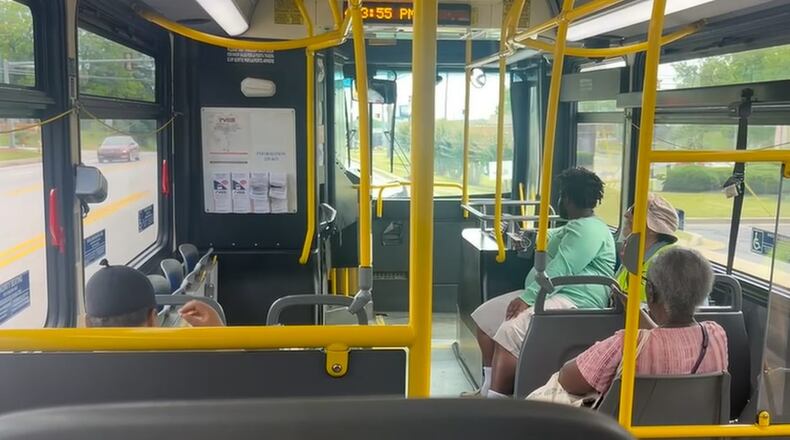This story was originally published by the Ledger-Enquirer.
Columbus’ public transit map swirls and dips around the city with jagged curves and turns. The 10 colorful routes wend through neighborhoods like arteries, stopping once per hour with buses that cater to a sliver of Columbus residents.
But only around 1% of the population opts to hop on the METRA bus in Columbus, under serving a community that is heavily reliant on mostly gas-powered vehicles to get around. Without a viable connectivity options, cars and trucks will remain the primary transportation method for Columbusites.
And with that comes the greenhouse gas emissions that studies conclude contribute heavily to climate change.
Other cities in the U.S. of the same size as Columbus with 200,000 residents have anywhere from 11 to 18 times more people riding the bus every day, according to the Q3 2023 American Public Transportation Association ridership report.
- Rochester, New York, has 34,700 daily riders (16% of the population)
- Richmond, Virginia, 31,000 (17% of the population)
- Salt Lake City 37,000 (18% of the population)
- Eugene, Oregon, 21,000 (11% of the population)
METRA, Columbus’ public transit system’s current daily average (Monday-Saturday, as the bus does not run on Sunday) is 3,000, just 1.5% of the population. Knoxville, Tennessee has around 200,000 people and sees 7,800 riders per day, around 4% of the population.
This system has remained largely unchanged for nearly 40 years, only decreasing during COVID-19.
“The system predates me, and I’ve been here for 37 years,” Rosa Evans, METRA director of transportation said when discussing the system and route placement.
In 2019, about 4,000 people rode METRA, according to Evans. The pandemic slashed those numbers below 50% to just 1,500 daily riders.
“Our services are based on the demand for our community as others are for their respective communities,” Evans said via email and cited comprehensive transportation studies as a measure of what the city needs.
Credit: Kala Hunter
Credit: Kala Hunter
The new, $600,000 dollar, TSPLOST-funded park-and-ride does address connectivity gaps in the city adding a bike tuning station near the Dragonfly Trail. The Linwood Park-and-Ride is the 10th in the city. It’s equipped with 28 parking spaces (two of which are Level-2 EV charging spaces).
“The location provides citizens with connectivity to biking, walking, jogging, and transit,” Evans said in an email.
Adding bike lanes and sidewalks can improve mobility options and decarbonize the city. These efforts are underway, being laid to the ground currently.
Aside from this new park-and-ride project, where folks can drive and then walk about a minute to the METRA transit center, it isn’t clear how METRA is attracting ridership.
An inconvenient experience
Carolyn Edwards-Golden, a community leader and advocate for people with disabilities, believes the bus stops lack acceptable standards and reliability. Edwards-Golden settled in Columbus 26 years ago, after living in many cities in the U.S. and abroad because of her husband’s military commitments.
“When I first arrived in Columbus I was shocked at the bus system here,” Edwards-Golden said. “What I noticed then and now is I can be in any part of Columbus and see uncovered bus ports.”
Edwards-Golden went to several city meetings about a decade ago to get METRA equipped with wheelchair ramps. Today the buses have ramps. But, Edwards-Golden still doesn’t believe METRA is adequate for a city this size.
“This city should have an adequate bus system as the second-largest city in Georgia,” she said. “If I needed to get downtown 30 minutes from now I don’t think I could. I don’t believe that it is possible.”
Route 5 to North Highland–PeachTree Mall and Route 7 serving South Columbus used to have more frequent stop times, every 30 minutes, pre-pandemic.
“We’re looking at reinstating the 30-minute frequency to these two routes because these have heavier ridership again,” Evans said. “We’re still determining this.”
Credit: METRA
Credit: METRA
The last time a transit study was conducted was in 2018 and it found routes to discontinue from low ridership. There were 12 routes before the current 10.
“The Transit Assessment conducted in 2018 showed that there was no demand for Sunday service,” Evans added in an email.
There are no plans to create Sunday rides.
“The local people who pay taxes, who buy retail, and buy everything they need to live in the city, need a comfortable, decent bus,” Edwards-Golden said.
The METRA riders
One of the 3,000 METRA riders is Kenneth Baker. A Columbus native who lives in North Highlands and rides METRA’s Route 5 south on 2nd Avenue to get to his job at the Marriott in Uptown. He’s been doing this for 24 years. Sometimes he will carpool with his co-worker, all in an effort to save on the expenses of having a car.
“I take Route 5 and then transfer to Route 4 and walk to the Marriott,” Baker said. “I save about $200 a month to ride the bus instead of paying for car insurance.”
Credit: Kala Hunter
Credit: Kala Hunter
Baker has an unlimited swipe card, which costs $53 for an adult or $26.50 for a person with a disability or a senior.
Without the unlimited swipe card, the ride costs $1.30, and transferring costs an additional $1.30. No change is given.
Baker can remember when bus stop times were listed at the stop. As an avid rider, he has the stop times memorized but for a new rider, they would have to have a smartphone, use the METRA app or another map app, and plan routes ahead of time to avoid waiting an hour.
“There were signs posted at key route locations many years ago (not all stops),” Evans said in an email. “They were removed due to vandalism and the cost to replace them.”
On a balmy Friday afternoon, Adam Kangas rode Route 10 north, beginning at the transfer station. His wife was using their car so he rode his bike from his home in Lakebottom to the transit center to make it to an afternoon mass.
Kangas’ bike was strapped to the front of the bus. The bus swiftly navigated through the northern part of Columbus to the Holy Transfiguration Greek Orthodox Church.
The air conditioning circulates on the bus, providing respite. But the bus stop is a different experience.
On Route 10 southbound, a mother holds her child on her lap as his eyes widen with the rapidly moving world around him. The bus stops in front of the Neighborhood Walmart on Manchester Expressway, picking up three people holding loaded gray plastic bags filled with groceries. The bus was about one-third full at 4:00 in the afternoon. This stop, as well as many in the city, has no shelter or cover to provide shade in the heat or a shield in the rain.
About a quarter of the $18.4 million transportation fund comes from city taxes at $4 million.
Ridership fees only bring in $541,000, according to the 2024 Columbus City Government budget report.
Electrification efforts and studies
Evans cited several reasons that the bus shelters are not always needed in an email.
“Too many shelters that are not needed will clutter the city’s Right-of-Way and can be costly, shelters not needed will also attract persons who are homeless (rather than transit users), and transit passengers generally know the bus arrival time to avoid long waits and will bring an umbrella for inclement weather,” she wrote.
Credit: Kala Hunter
Credit: Kala Hunter
METRA has a fleet of 35 buses and relies on 15 that service the 10 routes from 4:30am-8:30pm. The buses all run on diesel except the paratransit which runs on gasoline.
METRA uses around 550 gallons of diesel per day, according to Evans.
Averaging $4 per gallon of diesel, METRA spends $792,000 thousand per year METRA on fuel.
METRA only makes up a piece (less than 1%) of 1,465 metric tons of carbon dioxide emissions annually. (calculated using a formula provided by the EPA)
Cars are the carbon culprit in Columbus. There are 170,738 registered motor vehicles (675 are electric) in Muscogee County.
METRA has made commitments to remove diesel fuels from their fleet in the coming decades because the Federal Transit Authority is requesting transit systems to electrify. Diesel is known to be a harmful and carcinogenic pollutant.
There is a litany of hazardous pollutants that are carcinogenic (cancer-causing) when inhaling diesel contribute to asthma, lung development, and even mental capabilities.
“We have grant funding that we applied for to purchase four electric buses,” Evans said. “Right now we’re in the process of getting infrastructure set up. The first EV purchase will happen in the next year or two. By 2030, we are hoping to have at least half of the fleet to go electric and 2050 by fully electric.”
METRA plans to do a new comprehensive study in the fiscal year 2025 to study which routes will include on demand or micro transit service.
Credit: Ledger-Enquirer
Credit: Ledger-Enquirer
MEET OUR PARTNER
Today’s story comes from our partner the Ledger-Enquirer in Columbus. The Ledger-Enquirer provides daily coverage of community news, events, and sports in Columbus and the Chattahoochee Valley at ledger-enquirer.com.
If you have any feedback or questions about our partnerships, you can contact Senior Manager of Partnerships Nicole Williams via email at nicole.williams@ajc.com.
About the Author
Keep Reading
The Latest
Featured








